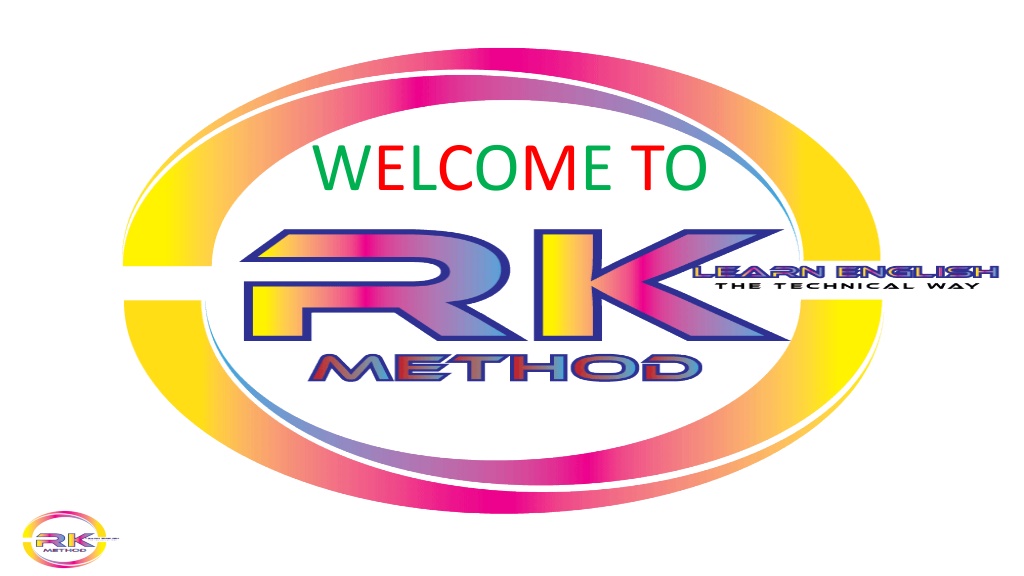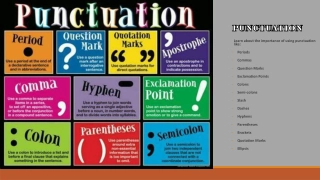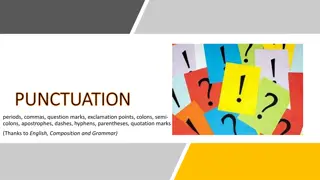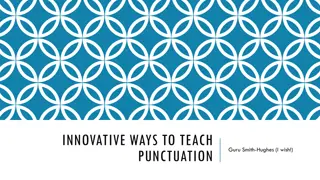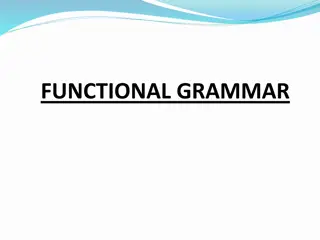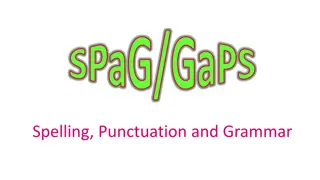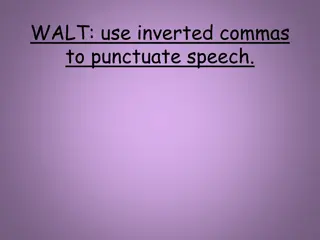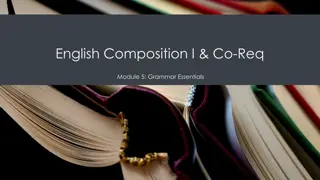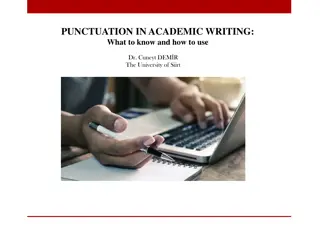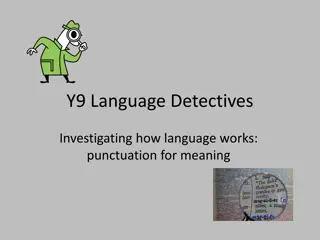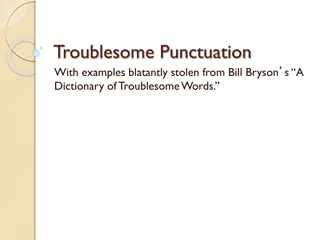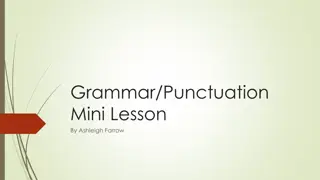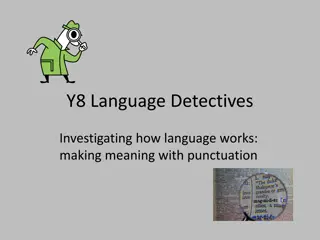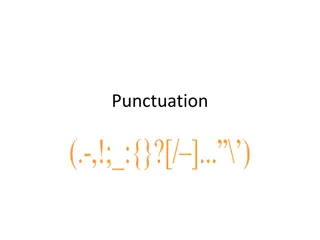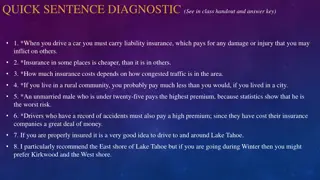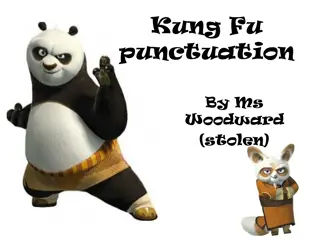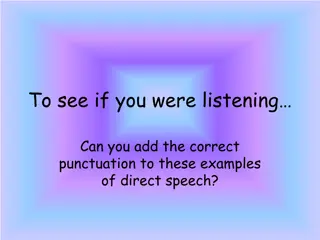Understanding Punctuation: A Comprehensive Guide for Students
Punctuation marks play a crucial role in conveying meaning and enhancing clarity in writing. This guide covers the definition of punctuation, its importance, types of punctuation marks, and examples of usage like full stops, commas, and more to help students master the art of punctuation.
Download Presentation

Please find below an Image/Link to download the presentation.
The content on the website is provided AS IS for your information and personal use only. It may not be sold, licensed, or shared on other websites without obtaining consent from the author. Download presentation by click this link. If you encounter any issues during the download, it is possible that the publisher has removed the file from their server.
E N D
Presentation Transcript
Teachers Identity RANJIT KISKU B.A (HON S) , M.A IN ENGLISH ASSISTANT TEACHER-ENGLISH ST. PHILIP S HIGH SCHOOL AND COLLEGE Class : Seven Subject : English 2nd Paper
THE PUNTUATION MARKS CAPITALIZATION
Learning Outcomes By the end of the lesson students will be able . To define punctuation marks. To understand why punctuation marks are used. To understand the principal punctuation marks. To use punctuation marks & capitalization correctly in writing. Let s get started
What is punctuation? Punctuation means a set of marks or signs in English to show pause or stops in the text / in writing . These signs clarify the meaning of the sentence/text. He lost lands , money , reputation and friends . The highlighted symbols are called punctuation as it is used to show stops or pause in the line while reading , writing and speaking.
Why punctuation is used? While speaking or reading we add stops directly to convey the meaning properly. In writing we add stops or pause via punctuation to make the readers understand what the writer is saying. Clarify meaning by linking or separating Phrases Clauses Words
Types of punctuation marks The following are the principal stops or pause; . Note: There are other punctuation marks as well that we will learn in our next class. Full stop/Period , Comma Exclamation mark ! Punctuation marks ; Semicolon Question mark ? : Colon
Full stop/Period . Greatest pause or break. Marks the end of assertive or imperative sentences. Show abbreviations Example; St. Philip s high school and college is a famous institution in the north Bengal. Please note down the point. Mr. Monir is an U.N.O. Note: In modern English, we can avoid full stop for abbreviation in our writing . For example; M.A = MA M.P = MP U.N.O = UNO
Comma , It has many usages in our writing but we will learn the major uses of it. He wrote his exercise neatly , quickly and correctly. To separate a series of words. Rich and poor , high and low , literate and illiterate , must die one day. To separate pair of words . To mark off clauses and phrases in the long sentences. If you come , I will go with you. Aman , being a poor man , does his duty sincerely. To mark off a noun or phrases in apposition. Mr. Fahad , a student of SPSC, is an honest boy. For more practice you must follow your text book and reference books. English, St. Philip s High School And College.
Semicolon; The semicolon signals a pause longer than a comma but briefer than a period. There are two uses for a semicolon: 1. To separate two independent clauses. One or both of the clauses are short and the ideas expressed are usually very similar. What an incredible situation ; it must make you nervous 2. To separate groups of words that are themselves separated by commas. They plan to study German, for their travels ; chemistry, for their work ; and literature, for their own enjoyment. Note: Do not use a capital letter after a semicolon, unless it is followed by a proper noun.
Colon : Pause greater that semicolon. To introduce a quotation. Before enumeration , examples etc. Example Francis Bacon says : Reading makes a full man, writing an exact man, speaking a ready man. The principal parts of a verb are : the present tense, the past tense , and the past participle. English, St. Philip s High School And College.
Question mark ? Mark off a direct question. To the end of interrogative sentence. Example How are you ? Have you done your exercise ? English, St. Philip s High School And College.
Exclamation mark! Used after interjections Used after phrases and sentences expressing sudden feelings, Emotion or wish. Example Alas ! I am undone. What a beautiful scenery it is ! English, St. Philip s High School And College.
Capitalization Capital letters are used in the following cases. To begin a sentence. Trees are very important element of nature. To begin all proper nouns and adjective from them. Bangladesh is a small country. African people are called black people. For all nouns and pronouns which indicates the deity. The Lord , He is almighty. To write the pronoun I and the interjection O. He asked me whether I was fine. To begin each fresh line of poetry. For more practice you must follow your text book and reference books.
Home Work 1.Punctuate the following context. If you read ten pages of a good book letter by letter that is to say with real accuracy you are for evermore in some measures an educated person there is only one cure for the evils which newly acquired freedom produces and that cure is freedom
THANK YOU English, St. Philip s High School And College.
Ranjit kisku, Assistant Teacher English, St. Philips High School And College.
